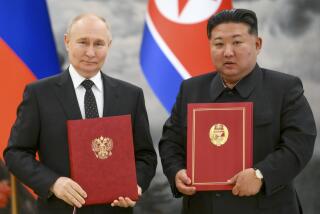N. Korean Missiles Have Russian Roots, Explosive Theory Suggests
- Share via
WASHINGTON — At the moment, some of the world’s leading experts on missile technology are intensively studying an explosive theory about North Korea’s infamous missiles.
It is a hypothesis with far-reaching ramifications for American diplomacy, but also one that sounds almost like a Hollywood movie script.
It goes like this: The North Korean missiles--the ones that frightened Japan and prompted the United States to begin thinking seriously about missile-defense systems--aren’t really North Korean at all. They’re Russian, secretly built with Russian components and the active and ongoing help of some errant Russian scientists inside North Korea.
Russian Involvement Under Scrutiny
Under this theory (and here’s the Hollywood plot), a rogue team of Russian missile scientists--thrown out of work after the collapse of the Soviet Union--may have moved to North Korea. And there, for profit or glory or both, they have directed the North Korean program--with the North Koreans themselves doing little more than putting the pieces together.
The missile experts who have been gathering evidence to support this theory phrase it in much drier terms, of course.
“It must be concluded that various Russian companies--not necessarily the Russian government--and North Korean authorities are closely cooperating in the missile programs,” wrote German missile technology specialist Robert H. Schmucker in a recent paper.
“From these [Russian] institutions, North Korea received everything necessary to manufacture or assemble missiles. . . . The future of North Korea’s work and success depends completely on the Russian involvement.”
Timothy McCarthy, senior analyst at the Monterey Institute of International Studies, says he has been quietly examining for months the possibility that some Russians are continuing to provide key components for the North Korean missiles.
There is no evidence to suggest that the Russian government has been involved. Russian President Vladimir V. Putin visited Pyongyang last July and suggested afterward that North Korea might be willing to abandon missile development if other nations would launch North Korean satellites.
Still, if even individual Russian scientists or factories were privately helping to produce the North Korean missiles, there would be important implications for U.S. foreign policy.
“If the North Korean program isn’t viable without Russian components, then you’d have to look at Russia, not North Korea, for the solution to the problem,” McCarthy says.
Missile Experts Debate Theory
So far, U.S. intelligence agencies are said to be skeptical about this theory.
However, the idea has gained adherents among missile experts in Europe, particularly in Germany. Since the Gulf War, when it was revealed that German firms were supplying Saddam Hussein’s missile program in Iraq, the Germans have played a growing role in combating missile proliferation.
And so a subterranean debate has broken out among missile experts about the degree of Russian involvement in producing North Korea’s missiles.
Virtually everyone agrees that, at a minimum, the North Korean program began in the 1980s with Russian help, and that the North Korean missiles are based upon Russian designs.
“We’ve taken a close look at the design of the [Korean missile] and it’s clearly a knockoff of the [Russian] SS-4,” says John Pike of the Federation of American Scientists.
It’s also undisputed that in October 1992, Russian security officials detained more than 60 Russian missile specialists at Moscow’s Sheremetyevo airport as they were about to leave for North Korea. The scientists were from the Makayev state missile center in the Ural Mountains, which was in the midst of budget cutbacks.
With these facts, the consensus ends. Some experts believe the Russian help for the North Korean missiles stopped in the early 1990s. “The paper trail ended eight years ago,” says Pike.
But others believe the Russian work has continued right up to today. They point to the Russian-style design of the North Korean missiles and to the fact that they were developed more rapidly, and with fewer flight tests, than those of other nations.
“Countries like Egypt, South Africa, Brazil, Chile and Egypt all tried to develop these missiles and failed,” says Joachim Krause, deputy director of a German research institute. “Only North Korea, this totally run-down country that can’t feed its own people, succeeded.”
There also have also been some remarkable customs seizures in Europe of missile parts that North Korea was exporting, these experts say. The parts appear to be Russian. “The components bear Cyrillic markings on them,” McCarthy says.
Expert Says Missile Has Russian System
Those who see a Russian hand behind the North Korea program argue that although the Makayev missile scientists failed to make it through the Moscow airport in 1992, some of them could have reached North Korea on their own.
Schmucker, a propulsion engineer who advises the German government and who earlier served on the U.N. commission for Iraq, says there are “so many indications [of Russian involvement], and there is no other way. . . .
“The North Korean missile is a complete Russian system, with nothing developed in North Korea,” he concludes.
* Jim Mann’s column appears in this space every Wednesday.
More to Read
Sign up for Essential California
The most important California stories and recommendations in your inbox every morning.
You may occasionally receive promotional content from the Los Angeles Times.













